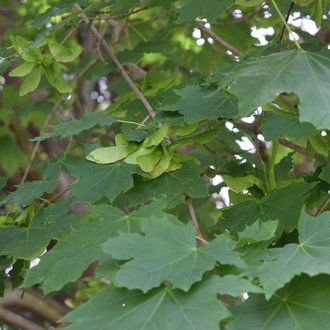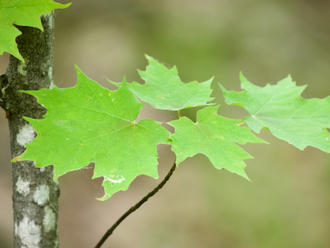Sugar Maple (Acer saccharum Marshall)
Also classified as Acer barbatum Michx.
This and related taxa are subject to a surprising amount of taxonomic disagreement. Although most older sources recognize black maple (Acer nigrum) as a separate species, POWO lumps it in with this species, not even treating it as a variety. POWO recognizes only three subtaxa of this species: the standard var. saccharum, "Schneck's maple", var. schneckii, and var. rugelii, a variety so esoteric it does not even have a common name, and not recognize by most authorities. POWO separates southern sugar maple (Acer saccharum subsp. floridanum) as its own species, whereas other sources often lump it in with this one. Similarly, POWO separates chalk maple (Acer leucoderme), but many authorities also treat it as a subspecies of this one. We have not yet reviewed all these inconsistencies and decided which scheme to follow, so for now our treatment of these taxa may be inconsistent. For now, treat our pages on these species as messy and incomplete.
↑Summary
A shade-tolerant deciduous tree of the northeast, often associated with climax communities on rich, mesic sites.
↑Range - Expand
| Legend | Color |
| Native | |
| Introduced or Not Present | |
| Native or Expanded | |
| Native or Not Present |
This tentative map is based on our own research. It may have limited data on Canada and/or Mexico, and there is some subjectivity in our assignment of plants as introduced vs. expanded. Read more in this blog post.
Although this plant occurs somewhere in each of these regions, it may only occur in a small part of some or all of them.
Populations in California and probably Georgia as well are introductions from landscaping plants; we marked the GA populations as "Expanded" because they are adjacent to this species' native range.
↑Similar Plants
↑Habitat
Most common in rich, mesic woods, usually growing on flat areas or adjacent lower slopes, but also found on higher slopes. Dominant or co-dominant in several forest types, particularly northern hardwood forests, beech-maple forests (with American beech), basswood-maple forests (with American basswood), mixed mesophytic forests, and common in many more, including some mixed conifer-hardwood forests. Often found on well-drained sites in bottomlands, such as elevated terraces in floodplains.
Grows best in well-drained, loamy soil rich in organic matter, although it can tolerate some sand, rock, or clay in the soil. Often associated with alluvial soils or calcium-rich soils. Can occur on sandy and rocky soils if there is sufficient moisture and conditions are otherwise ideal. Intolerant of flooding.
Prefers at least some protection from wind, either from the topography or from the dense vegetative growth in a forest.
Intolerant of pollution and acid rain, this species is usually only found in high-quality natural habitats and is absent from disturbed areas and urban areas.
Fire-intolerant, and has benefitted from fire suppression.
↑Life Cycle
Among the most shade-tolerant of deciduous trees in its range, the sugar maple is often associated with climax communities.
Seedlings germinate in the spring, after a period of cold dormancy. Seeds rarely germinate after the first year, and there is no appreciable seed banking. Seedlings are highly shade tolerant and can persist for years under a closed canopy.
Seedlings respond with rapid growth to a gap. In open-canopy forests, seedlings can grow up to reach the canopy under the shade of less shade-tolerant species.
Trees usually begin producing seed around 30-40 years of age, but seed production is low until 70-100 years of age. Seed production varies by year, both due to individual tree genetics and local weather conditions. Some trees produce seed consistently each year, whereas others fluctuate with peak crops somewhere between every 2 and 7 years.
Flowers are wind-pollinated, but attract more insects than most strictly wind-pollinated trees, and there has been some uncertainty about whether or not they are also insect-pollinated. Seeds are wind-dispersed, but the relatively heavy seeds are typically not carried very far from the parent tree.
Trees can live 300 to 400 years.
↑Uses
Used in the production of maple sugar, for which this species is named. The sugar maple is preferred for this purpose due to the high sugar content of its sap.
Also used for its wood, which is more desirable than some other maple species.
Sometimes planted as a landscaping plant or shade tree. Formerly, more widely planted as a street tree, but usage declined with the rise of the automobile due to intolerance of pollution from automobiles, more heavily-paved urban areas, and salt. Like other maples, the surface roots can heave sidewalks more than other trees of similar size, so this species isn't a great choice of street tree even where it can survive.
↑Links & External Resources
• Hard Maple | The Wood Database (About This Site)
• Sugar Maple | Fire Effects Information System (FEIS) (About This Site)
• Acer saccharum (Sugar Maple) | Illinois Wildflowers (About This Site)
• Acer saccharum (Sugar Maple) | USDA PLANTS Database (About This Site)
• Acer saccharum | Go Botany (About This Site)
• Sugar Maple | iNaturalist (About This Site)
• Acer saccharum (Sugar Maple) | Missouri Botanical Garden Plant Finder (About This Site)
• Sugar Maple | Virginia Tech Dendrology Factsheets (About This Site)
• Sugar Maple | Silvics of North America (About This Site)
• Acer saccharum | Biota of North America Project (BONAP) (About This Site)
• Acer saccharum | NatureServe Explorer (About This Site)
• Sugar Maple | Maryland Biodiversity Project (About This Site)
• Acer saccharum Marshall var. saccharum (Sugar Maple) | Digital Atlas of the Virginia Flora (About This Site)























